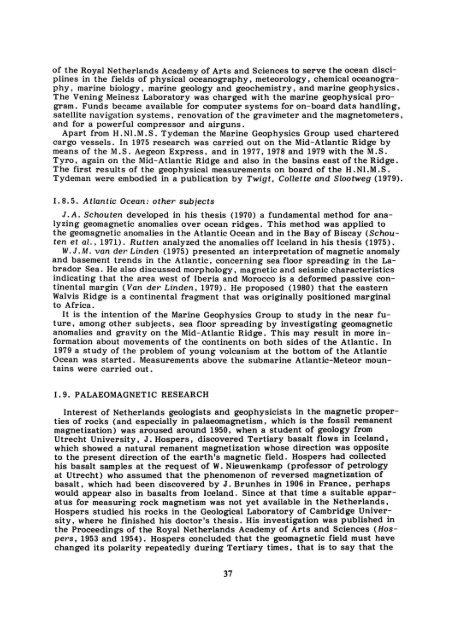History of Geophysical Research in The Netherlands ... - DWC - KNAW
History of Geophysical Research in The Netherlands ... - DWC - KNAW
History of Geophysical Research in The Netherlands ... - DWC - KNAW
You also want an ePaper? Increase the reach of your titles
YUMPU automatically turns print PDFs into web optimized ePapers that Google loves.
<strong>of</strong> the Royal <strong>Netherlands</strong> Academy <strong>of</strong> Arts and Sciences to serve the ocean discipl<strong>in</strong>es<br />
<strong>in</strong> the fields <strong>of</strong> physical oceanography. meteorology. chemical oceanography.<br />
mar<strong>in</strong>e biology. mar<strong>in</strong>e geology and geochemistry. and mar<strong>in</strong>e geophysics.<br />
<strong>The</strong> Ven<strong>in</strong>g Me<strong>in</strong>esz Laboratory was charged with the mar<strong>in</strong>e geophysical program.<br />
Funds became available for computer systems for on-board data handl<strong>in</strong>g.<br />
satellite navigation systems. renovation <strong>of</strong> the gravimeter and the magnetometers.<br />
and for a powerful compressor and airguns.<br />
Apart from H. Nl.M. S. Tydeman the Mar<strong>in</strong>e Geophysics Group used chartered<br />
cargo vessels. In 1975 research was carried out on the Mid-Atlantic Ridge by<br />
means <strong>of</strong> the M.S. Aegeon Express. and <strong>in</strong> 1977. 1978 and 1979 with the M.S.<br />
Tyro. aga<strong>in</strong> on the Mid-Atlantic Ridge and also <strong>in</strong> the bas<strong>in</strong>s east <strong>of</strong> the Ridge.<br />
<strong>The</strong> first results <strong>of</strong> the geophysical measurements on board <strong>of</strong> the H.Nl.M.S.<br />
Tydeman were embodied <strong>in</strong> a publication by Twigt. Collette and Slootweg (1979).<br />
1.8.5. Atlantic Ocean: other subjects<br />
J. A. Schouten developed <strong>in</strong> his thesis (1970) a fundamental method for analyz<strong>in</strong>g<br />
geomagnetic anomalies over ocean ridges. This method was applied to<br />
the geomagnetic anomalies <strong>in</strong> the Atlantic Ocean and <strong>in</strong> the Bay <strong>of</strong> Biscay (Schouten<br />
et al.. 1971). Rutten analyzed the anomalies <strong>of</strong>f Iceland <strong>in</strong> his thesis (1975).<br />
W. J. M. van der L<strong>in</strong>den (1975) presented an <strong>in</strong>terpretation <strong>of</strong> magnetic anomaly<br />
and basement trends <strong>in</strong> the Atlantic • concern<strong>in</strong>g sea floor spread<strong>in</strong>g <strong>in</strong> the Labrador<br />
Sea. He also discussed morphology. magnetic and seismic characteristics<br />
<strong>in</strong>dicat<strong>in</strong>g that the area west <strong>of</strong> Iberia and Morocco is a deformed passive cont<strong>in</strong>ental<br />
marg<strong>in</strong> (Van der L<strong>in</strong>den. 1979). He proposed (1980) that the eastern<br />
Walvis Ridge is a cont<strong>in</strong>ental fragment that was orig<strong>in</strong>ally positioned marg<strong>in</strong>al<br />
to Africa.<br />
It is the <strong>in</strong>tention <strong>of</strong> the Mar<strong>in</strong>e Geophysics Group to study <strong>in</strong> thè near future.<br />
among other subjects. sea floor spread<strong>in</strong>g by <strong>in</strong>vestigat<strong>in</strong>g geomagnetic<br />
anomalies and gravity on the Mid-Atlantic Ridge. This may result <strong>in</strong> more <strong>in</strong>formation<br />
about movements <strong>of</strong> the cont<strong>in</strong>ents on both sides <strong>of</strong> the Atlantic. In<br />
1979 a study <strong>of</strong> the problem <strong>of</strong> young volcanism at the bottom <strong>of</strong> the Atlantic<br />
Ocean was started. Measurements above the submar<strong>in</strong>e Atlantic-Meteor mounta<strong>in</strong>s<br />
were carried out.<br />
I. 9. PALAEOMAGNETIC RESEARCH<br />
Interest <strong>of</strong> <strong>Netherlands</strong> geologists and geophysicists <strong>in</strong> the magnetic properties<br />
<strong>of</strong> rocks (and especially <strong>in</strong> palaeomagnetism. which is the fossil remanent<br />
magnetization) was aroused around 1950. when a student <strong>of</strong> geology from<br />
Utrecht University. J. Hospers • discovered Tertiary basalt flows <strong>in</strong> Iceland.<br />
which showed a natural remanent magnetization whose direction was opposite<br />
to the present direction <strong>of</strong> the earth '5 magnetic field. Hospers had collected<br />
his basalt samples at the request <strong>of</strong> W. Nieuwenkamp (pr<strong>of</strong>essor <strong>of</strong> petrology<br />
at Utrecht) who assumed that the phenomenon <strong>of</strong> reversed magnetization <strong>of</strong><br />
basalt. which had been discovered by J. Brunhes <strong>in</strong> 1906 <strong>in</strong> France. perhaps<br />
would appear also <strong>in</strong> basalts from Iceland. S<strong>in</strong>ce at that time a suitable apparatus<br />
for measur<strong>in</strong>g rock magnetism was not yet available <strong>in</strong> the <strong>Netherlands</strong> •<br />
Hospers studied his rocks <strong>in</strong> the Geological Laboratory <strong>of</strong> Cambridge University.<br />
where he f<strong>in</strong>ished his doctor's thesis. His <strong>in</strong>vestigation was published <strong>in</strong><br />
the Proceed<strong>in</strong>gs <strong>of</strong> the Royal <strong>Netherlands</strong> Academy <strong>of</strong> Arts and Sciences (Hospers.<br />
1953 and 1954). Hospers concluded that the geomagnetic field must have<br />
changed its polarity repeatedly dur<strong>in</strong>g Tertiary times. that is to say that the<br />
37

















